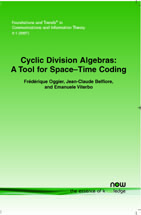Cyclic Division Algebras: A Tool for Space–Time Coding
By Frédérique Oggier, Department of Electrical Engineering, California Institute of Technology, frederique@systems.caltech.edu | Jean-Claude Belfiore, École Nationale Supérieure des Télécommunications, France, belfiore@enst.fr | Emanuele Viterbo, Dipartimento di Elettronica, Informatica e Sistemistica, Università della Calabria, Italy, viterbo@deis.unical.it
Abstract
Multiple antennas at both the transmitter and receiver ends of a wireless digital transmission channel may increase both data rate and reliability. Reliable high rate transmission over such channels can only be achieved through Space–Time coding. Rank and determinant code design criteria have been proposed to enhance diversity and coding gain. The special case of full-diversity criterion requires that the difference of any two distinct codewords has full rank.
Extensive work has been done on Space–Time coding, aiming at finding fully diverse codes with high rate. Division algebras have been proposed as a new tool for constructing Space–Time codes, since they are non-commutative algebras that naturally yield linear fully diverse codes. Their algebraic properties can thus be further exploited to improve the design of good codes.
The aim of this work is to provide a tutorial introduction to the algebraic tools involved in the design of codes based on cyclic division algebras. The different design criteria involved will be illustrated, including the constellation shaping, the information lossless property, the non-vanishing determinant property, and the diversity multiplexing trade-off. The final target is to give the complete mathematical background underlying the construction of the Golden code and the other Perfect Space–Time block codes.
Cyclic Division Algebras
Multiple antennas at both the transmitter and receiver ends of a wireless digital transmission channel may increase both data rate and reliability. Reliable high rate transmission over such channels can only be achieved through Space-Time coding. Rank and determinant code design criteria have been proposed to enhance diversity and coding gain. The special case of full-diversity criterion, requires that the difference of any two distinct codewords has full rank. Extensive work has been done on Space-Time coding, aiming to attain fully diverse codes with high rate. Division algebras have been proposed as a new tool for constructing Space-Time codes, since they are non-commutative algebras that naturally yield linear fully diverse codes. Their algebraic properties can thus be further exploited to improve the design of good codes.
Cyclic Division Algebras: A Tool for Space-Time Coding provides a tutorial introduction to the algebraic tools involved in the design of codes based on division algebras. The different design criteria involved are illustrated, including the constellation shaping, the information lossless property, the non-vanishing determinant property and the diversity multiplexing tradeoff. Finally complete mathematical background underlying the construction of the Golden code and the other Perfect Space-Time block codes is given.
Cyclic Division Algebras: A Tool for Space-Time Coding is for students, researchers and professionals working on wireless communication systems.
